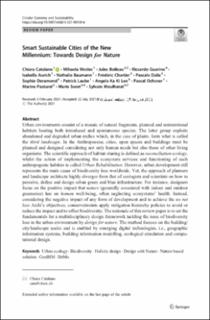Please use this identifier to cite or link to this item:
https://doi.org/10.21256/zhaw-23036| Publication type: | Article in scientific journal |
| Type of review: | Peer review (publication) |
| Title: | Smart sustainable cities of the new millennium : towards design for nature |
| Authors: | Catalano, Chiara Meslec, Mihaela Boileau, Jules Guarino, Riccardo Aurich, Isabella Baumann, Nathalie Chartier, Frédéric Dalix, Pascale Deramond, Sophie Laube, Patrick Lee, Angela Ka Ki Ochsner, Pascal Pasturel, Marine Soret, Marie Moulherat, Sylvain |
| et. al: | No |
| DOI: | 10.1007/s43615-021-00100-6 10.21256/zhaw-23036 |
| Published in: | Circular Economy and Sustainability |
| Volume(Issue): | 1 |
| Issue: | 3 |
| Page(s): | 1053 |
| Pages to: | 1086 |
| Issue Date: | 25-Aug-2021 |
| Publisher / Ed. Institution: | Springer |
| ISSN: | 2730-597X 2730-5988 |
| Language: | English |
| Subjects: | Urban ecology; DeMo; Biodiversity; Geodesign; GeoBIM; Holistic design; Design with nature |
| Subject (DDC): | 711: Area planning |
| Abstract: | Urban environments consist of a mosaic of natural fragments, planned and unintentional habitats hosting both introduced and spontaneous species. The latter group exploits abandoned and degraded urban niches which, in the case of plants, forms what is called the Third Landscape. In the Anthropocene, cities, open spaces and buildings must be planned and designed considering not only human needs but also those of other living organisms. The scientific approach of habitat sharing is defined as Reconciliation Ecology, whilst the action of implementing the ecosystem services and functioning of such anthropogenic habitats is called Urban Rehabilitation. However, urban development still represents the main cause of biodiversity loss worldwide. Yet, the approach of planners and landscape architects highly diverges from that of ecologists and scientists on how to perceive, define and design urban green and blue infrastructure. For instance, designers focus on the positive impact that Nature (generally associated with indoor and outdoor greeneries) has on human well-being, often neglecting ecosystems’ health. Instead, considering the negative impact of any form of development and to achieve the No Net Loss Aichi’s objectives, conservationists apply mitigation hierarchy policies to avoid or reduce the impact and to offset biodiversity. The rationale of this review paper is to set the fundamentals for a multidisciplinary design framework tackling the issue of biodiversity loss in the urban environment by design for Nature. The method focuses on the building/city/landscape scales and is enabled by emerging digital technologies, i.e. Geographic Information Systems, Building Information Modelling, ecological simulation and computational design. |
| URI: | https://digitalcollection.zhaw.ch/handle/11475/23036 |
| Fulltext version: | Published version |
| License (according to publishing contract): | CC BY 4.0: Attribution 4.0 International |
| Departement: | Life Sciences and Facility Management |
| Organisational Unit: | Institute of Facility Management (IFM) Institute of Natural Resource Sciences (IUNR) |
| Published as part of the ZHAW project: | DeMo. Entwurf und Modellierung städtischer Ökosysteme: Ein räumlich basierter Ansatz zur Integration von Lebensräumen in gebauten Ökosystemen |
| Appears in collections: | Publikationen Life Sciences und Facility Management |
Files in This Item:
| File | Description | Size | Format | |
|---|---|---|---|---|
| 2021_Catalano-etal_Smart-sustainable-cities-design-for-nature.pdf | 2.83 MB | Adobe PDF |  View/Open |
Show full item record
Catalano, C., Meslec, M., Boileau, J., Guarino, R., Aurich, I., Baumann, N., Chartier, F., Dalix, P., Deramond, S., Laube, P., Lee, A. K. K., Ochsner, P., Pasturel, M., Soret, M., & Moulherat, S. (2021). Smart sustainable cities of the new millennium : towards design for nature. Circular Economy and Sustainability, 1(3), 1053–1086. https://doi.org/10.1007/s43615-021-00100-6
Catalano, C. et al. (2021) ‘Smart sustainable cities of the new millennium : towards design for nature’, Circular Economy and Sustainability, 1(3), pp. 1053–1086. Available at: https://doi.org/10.1007/s43615-021-00100-6.
C. Catalano et al., “Smart sustainable cities of the new millennium : towards design for nature,” Circular Economy and Sustainability, vol. 1, no. 3, pp. 1053–1086, Aug. 2021, doi: 10.1007/s43615-021-00100-6.
CATALANO, Chiara, Mihaela MESLEC, Jules BOILEAU, Riccardo GUARINO, Isabella AURICH, Nathalie BAUMANN, Frédéric CHARTIER, Pascale DALIX, Sophie DERAMOND, Patrick LAUBE, Angela Ka Ki LEE, Pascal OCHSNER, Marine PASTUREL, Marie SORET und Sylvain MOULHERAT, 2021. Smart sustainable cities of the new millennium : towards design for nature. Circular Economy and Sustainability. 25 August 2021. Bd. 1, Nr. 3, S. 1053–1086. DOI 10.1007/s43615-021-00100-6
Catalano, Chiara, Mihaela Meslec, Jules Boileau, Riccardo Guarino, Isabella Aurich, Nathalie Baumann, Frédéric Chartier, et al. 2021. “Smart Sustainable Cities of the New Millennium : Towards Design for Nature.” Circular Economy and Sustainability 1 (3): 1053–86. https://doi.org/10.1007/s43615-021-00100-6.
Catalano, Chiara, et al. “Smart Sustainable Cities of the New Millennium : Towards Design for Nature.” Circular Economy and Sustainability, vol. 1, no. 3, Aug. 2021, pp. 1053–86, https://doi.org/10.1007/s43615-021-00100-6.
Items in DSpace are protected by copyright, with all rights reserved, unless otherwise indicated.